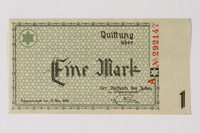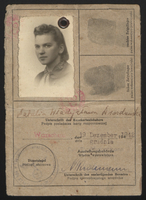Overview
- Brief Narrative
- 20 (zwanzig) mark receipt issued in the Łódź ghetto acquired by Wanda Neumark. The Germans used ghettos to segregate and control the Jewish population. All currency and valuables were confiscated and a system of scrip or Quittungen [receipts] that could be exchanged only in the ghetto was implemented. After Germany invaded Poland in September 1939, Wanda, 20, her parents Salomon and Ewa, and her younger sisters Hela and Teresa were confined to the Radomsko ghetto. Wanda escaped with the help of Henryk Wroblewski and assumed a non-Jewish identity as Natalia Władysława Drozdowska. Her parents were murdered in Treblinka killing center in September 1942. Wanda was liberated in Busko-Zdroj by Soviet forces in January 1945. The war ended when Germany surrendered that May. Wanda and her sisters left for Austria. In June 1946, Wanda married a Jewish American soldier Jacob Lomazow and immigrated to the United States that October.
- Date
-
issue:
1940 May 15
- Geography
-
issue:
Litzmannstadt-Getto (Łódź, Poland);
Łódź (Poland)
- Credit Line
- United States Holocaust Memorial Museum Collection, Gift of Steven M. Lomazow
- Markings
- face, upper left, red ink : Nº 238557
face, lower left and upper right corner, black ink : 20
face, center, black ink : Quittung / über / Zwanzig Mark /0 / Der Aelteste der Juden / in Litzmannstadt / M. Rumkowski / Litzmannstadt, den 15 Mai 1940 [Receipt for Twenty mark / The Elder of the Jews in Litzmannstadt M Rumkowski / Litzmannstadt May 15 1940]
back, upper left corner, black ink : Quittung über / Zwanzig Mark
back, bottom, black ink : WER DIESE QUITTUNG VERFÄLSCHT ODER NACHMACHT ODER GEFÄLSCHTE / QUITTUNGEN IN VERKEHR BRINGT / WIRD STRENGSTENS BESTRAFT [Anyone who falsifies or copies this receipt, or traffics in counterfeit receipts, will be strictly punished]
back, lower right, black ink : 20 - Contributor
-
Subject:
Wanda Lomazow
- Biography
-
Wanda Neumark (Neimark) was born in Łódź, Poland, in 1919 to Ewa and Salomon Neumark. She had two younger sisters, Hala, (later Helen Fagin) born in 1922, and Teresa, born in 1930. They were raised in Radomsko. In September 1939, Germany invaded and occupied Poland. The Jewish population of Radomsko were confined to a ghetto. Wanda escaped the ghetto with the help of Henryk Wroblewski. She assumed a non-Jewish alias, Natalia Władysława Drozdowska. She was living in Busko-Zdrój when the city was liberated in January 1945 by Soviet forces. The war ended when Germany surrendered on May 7, 1945. She learned that her parents were deported and murdered in Treblinka killing center in September 1942. Wanda and her sisters left for Austria. Wanda worked for United Nations Relief and Rehabilitation Administration (UNRRA) in Wels and Badgstein displaced persons camps. In June 1946, Wanda married a Jewish American soldier Jacob Lomazow (1917-2012) and, in October, immigrated to the United States. Wanda, 67, passed away in 1986.
Physical Details
- Language
- German
- Classification
-
Exchange Media
- Category
-
Money
- Object Type
-
Scrip (aat)
- Physical Description
- Łódź ghetto scrip printed on rectangular offwhite paper in brown and black ink. The face has a latticework underprint. The serial number is in red in the upper left corner. The denomination 20 is in the lower left corner and in the upper right corner in a black square. There is a 1.5 inch left margin, then a rectangle with a rounded upper left corner with a pattern of interlocked Stars of David and an encircled Star of David in the upper left corner. Across the center is the denomination Zwanzig Mark and German text. The back has a blank 1.5 inch right margin and a rectangle with a pattern of interlocked Stars of David. In the upper left corner is the denomination Zwanzig Mark and in the lower left corner is a menorah or 7-branched candelabrum. The denomination 20 is outside the lower right corner of the rectangle; above this, near the upper right corner, is a Star of David outline in a black square. The scrip is in like new condition.
- Dimensions
- overall: Height: 3.125 inches (7.938 cm) | Width: 6.250 inches (15.875 cm)
- Materials
- overall : paper, ink
Rights & Restrictions
- Conditions on Access
- No restrictions on access
- Conditions on Use
- No restrictions on use
Keywords & Subjects
Administrative Notes
- Legal Status
- Permanent Collection
- Provenance
- The scrip was donated to the United States Holocaust Memorial Museum in 1989 by Steven Lomazow.
- Funding Note
- The cataloging of this artifact has been supported by a grant from the Conference on Jewish Material Claims Against Germany.
- Record last modified:
- 2024-07-16 14:53:05
- This page:
- https://collections.ushmm.org/search/catalog/irn905
Download & Licensing
In-Person Research
- By Appointment
- Request 21 Days in Advance of Visit
- Plan a Research Visit
- Request to See This Object
Contact Us
Also in Wanda Lomazow collection
The collection consists of two pieces of Łódź ghetto scrip, documents, and a photograph relating to the experiences of Wanda Lomazow during the Holocaust when she lived under a false identity and after the Holocaust when she worked for United Nations Relief and Rehabilitation Administration (UNRRA) in Wels and Badgstein displaced persons camps, married Jacob Lomazow, and emigrated to the United States.
Date: approximately 1942-1946

Łódź (Litzmannstadt) ghetto scrip, 1 mark note, owned by a Polish Jewish survivor
Object
1 (eine) mark receipt issued in the Łódź ghetto acquired by Wanda Neumark. The Germans used ghettos to segregate and control the Jewish population. All currency and valuables were confiscated and, in Łódź, a system of scrip or Quittungen [receipts] that could be exchanged only in the ghetto was implemented. After Germany invaded Poland in September 1939, Wanda, 20, her parents Salomon and Ewa, and her younger sisters Hela and Teresa were confined to the Radomsko ghetto. Wanda escaped with the help of Henryk Wroblewski and assumed a non-Jewish identity as Natalia Władysława Drozdowska. Her parents were murdered in Treblinka killing center in September 1942. Wanda was liberated in Busko-Zdroj by Soviet forces in January 1945. The war ended when Germany surrendered that May. Wanda and her sisters left for Austria. In June 1946, Wanda married a Jewish American soldier Jacob Lomazow and immigrated to the United States that October.

Wanda Lomazow papers
Document
The Wanda Lomazow papers consist of identification papers under Wanda Lomazow's married name, maiden name, and false identity; United Nations Relief and Rehabilitation Administration (UNRRA) employment certificates in Wanda Lomazow's maiden name and false identity; travel permits for Wanda and Jacob Lomazow; the Lomazows' marriage certificate; and a photograph of Wanda Lomazow documenting Wanda Lomazow's survival of the Holocaust under a false identity, her postwar work for the UNRRA at the Wels and Bad Gastein displaced persons camps, her marriage to Jacob Lomazow, and her immigration to the United States.



